
Data processing equipment in the office, on the factory floor and across
the campus may come in a variety of 'flavors,' embracing terminals,
badge readers, alarm equipment and all types of manufacturing and
laboratory instruments. The serial EIA's RS-232 interface is perhaps the
most widespread interface found on different data devices. It is perhaps
the most universally found debarkation point for bringing data into and
out of these devices. Data communication connections between such
equipment in the premises environment can often be accomplished by
merely connecting interfaces together by a cable.
One problem arises though. While the RS-232 interface is the most
widespread interface, it is not ubiquitous. There are other interfaces,
notably RS-422 and RS-485. The need often arises to interconnect data
devices having different interfaces. Usually this need is to
interconnect a device having the popular RS-232 interface with a device
having something else like RS-485 or RS-422.
Of increasing interest is the problem of interface conversion when the
conversion is between RS-232 and RS-485. Networks based upon
communication between RS-485 interfaces commonly operate with a polling
protocol and employ a multi-dropped topology. One of the data devices is
designated 'master.' The others are designated 'slaves.' The master
communicates with the slaves in a query-response type of mode under the
control of software. Networks based on RS-485 are found in many
environments. These include locations that have Point of Sale terminals,
like supermarkets. These also include factory floor locations, where a
computer may be controlling automated tools. However, many of the data
devices which have to operate in an RS-485 network, may only have RS-232
interfaces - a 'master' minicomputer for the factory floor is an
excellent example. Hence, the need for RS-232 to RS-485 interface
conversion.
The Model 366 allows conversion between EIA's RS-232 and RS-485. This
unit can support up to 32 RS-485 stations on a multi-dropped network.
The Model 366 can even handle contention between RS-485 network users.
This is accomplished by dip switch settings and the use of the control
signal pair RTS/CTS. This signal pair is used to control the transmitter
and the receiver.
The Model 366 even includes a display. This provides the user with
important status information with regards to the operation of the device
and is extremely useful during installation and checkout and whenever
there are suspected problems. The display presents the user with the
live status of the data signals TD/RD and the control signals
RTS/CTS/DSR/DCD/DTR.
The illustration above shows the Model 366 in a typical application.
This is a multi-dropped polling network. Here we have the master
computer on the left communicating with various other data devices.
These include a plotter and two PCs.
|


